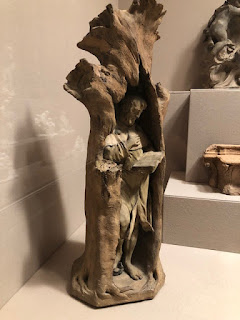This class, The Museum Experience, is aptly named as that is
exactly what one gets, an experience in visiting museums with a purpose. The
knowledge that a blog of the visit is to be kept makes one look at the art, ant
the museum itself, with a more discerning eye. I have visited many museums over
the years, in many cities, in several countries, always with a sense of awe and
amazement, not only of the beauty of the art, but also of the time that has
passed since many of the pieces were created. This is, in part, why I have been
fascinated by pieces from antiquity, the Renaissance, and Neoclassicism. The
passage of time has done little to detract from the beauty of much of the
creations of these periods.
Like many people, I assume, my first introduction to art came
from modernity. The works of Picasso, Van Gough, Rodin, Cezanne, Toulouse-Lautrec,
Gauguin, and Matisse, among others, have become instantly recognizable
throughout the world for a reason. They resonate still, more than a century
later, and inspire the imaginations of young and old alike.
I’ve been to the Metropolitan Museum of Art before, and the
time spent never seems to be enough. The vastness of the collections held within
are more than a single visit can do justice. As mentioned on the blog, it
should be visited at least twice a year to even have a remote chance to
experience the MET in all its glory.
The Bruce Museum is a nicely situated stately museum located
in Greenwich. The structure is impressive while the collection of art is not.
This is as much a science museum as an art one. This was easily my least
favorite experience of the class and a location I will not be returning to.
Yale Center for British Art was not one of my favorite museums
as I didn’t have an overwhelming interest, or appreciation, of British art. I
always had the image of an over representation of British aristocracy, or picturesque
sea-faring paintings. But this time, I was forced to slow down, put my
preconceptions aside, and look upon the collection through an uncluttered lens.
The Center itself is a work of art. The art itself, tells stories that represent
the history of the Britain Empire, which is significant. Additionally, the center is home to some
influential artists such as Whistler, Henry Moore, and Rubens. While still not
my area of choice, I have new found appreciation of British art, and the Shaw
exhibit was a revelation. I will be back for more.
The Yale Art Gallery is a place that I have also visited before,
in fact, it has become my go-to museum of choice, with its close location and
diversity of art. This museum contains great example of modern art that well
represents the period, as well as collections that highlight African art, European
art, ancient art, ancient art of the Americas, and the art form that was my first
love, photography.
The Wadsworth Atheneum Museum of Art was unknown to me prior
to this class, as such it was a very pleasant discovery. Surrealism is a
movement of which my interest was tepid at best, but the collection here provided
a lot of context that was enlightening in which I was better able to understand
to political element of much of the movement, particularly in response to the
Spanish Civil war. The only piece I was aware of in this regard was Picasso’s
Guernica, but I was introduced to so much more that was similarly created like Dali’s
Soft Construction with Boiled Beans and Apparition of Face and Fruit Dish on a
Beach.
In addition to the Modernist Surrealist paintings there where
Impressionist paintings, European decorative art, costume and textiles, and contemporary
art. The permanent collection alone has over fifty thousand works on display which
is enhanced by the temporary exhibits like the Edward Hopper Watercolors exhibition
or the Design in the American Home, 1650 to 1850 ongoing exhibit. The one draw back of the Wadsworth, is their rules regarding picture taking in much more restrictive than all the other museums. Regardless of that inconvenience, this newly,
for me, discovered museum will most certainly be on my frequently visited list
from now on, and has now given the Yale Art Galley competition for being my
favorite art museum in Connecticut. For this introduction alone, the class has
been a pleasurable, and educational, experience.
Best wishes to all.




























































